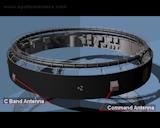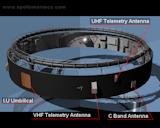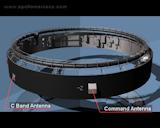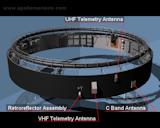飛行制御機器(IU)
- 直径:260in (6.604m)
- 高さ:36in (0.9144m)
- 平均重量:4500lb (2.04ton)
- 製造:IBM (International Business Machines Federal Systems Div. Huntsville, Ala.)
サターンIBで使用されたIUは、サターンV用に開発されたものとほとんど同じである。
物理的なサイズと搭載された機器のほとんどは全く同じである。
IUの主な機能は、ロケットの方向制御、エンジンの点火・停止制御、その他搭載機器のタイミング制御である。
詳細な情報については
サターンVの飛行制御機器(IU)
と
アポロ計画で使用されたコンピューター
をご覧ください。
関連書籍・ビデオ
-
The Apollo Guidance Computer: Architecture and Operation

Praxis 2010/7/11 5,004円
The technological marvel that facilitated the Apollo missions to the Moon was the on-board computer. In the 1960s most computers filled an entire room, but the spacecraft’s computer was required to be compact and low power. Although people today find it difficult to accept that it was possible to control a spacecraft using such a ‘primitive’ computer, it nevertheless had capabilities that are advanced even by today’s standards. This is the first book to fully describe the Apollo guidance computer’s architecture, instruction format and programs used by the astronauts. As a comprehensive account, it will span the disciplines of computer science, electrical and aerospace engineering. However, it will also be accessible to the ‘space enthusiast’. In short, the intention is for this to be the definitive account of the Apollo guidance computer.
-
Digital Apollo: Human and Machine in Spaceflight

The MIT Press 2011/9/30 2,778円
As Apollo 11's Lunar Module descended toward the moon under automatic control, a program alarm in the guidance computer's software nearly caused a mission abort. Neil Armstrong responded by switching off the automatic mode and taking direct control. He stopped monitoring the computer and began flying the spacecraft, relying on skill to land it and earning praise for a triumph of human over machine. In Digital Apollo, engineer-historian David Mindell takes this famous moment as a starting point for an exploration of the relationship between humans and computers in the Apollo program. In each of the six Apollo landings, the astronaut in command seized control from the computer and landed with his hand on the stick. Mindell recounts the story of astronauts' desire to control their spacecraft in parallel with the history of the Apollo Guidance Computer.
-
Saturn V Apollo Lunar Orbital Rendezvous Planning Guide

Apogee Prime 2011/07/15 USD24.95
The Saturn V Apollo Lunar Orbital Rendezvous Planning Guide is a reprint of a rare document from the early 1960s in which the whole Apollo moon landing mission was presented and illustrated. The book includes a large fold-out of the Apollo mission as well as a fold-out of the Saturn V moon rocket. It includes illustrations of early iterations of the Lunar Module, maps of the Cape Canaveral launch sites, launch schedules for all of the Apollo test flights, detailed specifications and schematics of the Saturn V launch vehicle stages, construction schedules, engine summaries, information on the VAB, mobile crawlers, Umbilical towers, a DVD and more
-
Mission Control

Gravitas Ventures 2017/07/27 USD24.99
At the heart of the Apollo space program and a remarkable decade of achievement was the team who worked in Mission Control.They were born against a backdrop of economic turmoil and global conflict. Some came from a rural lifestyle little changed from the 19th century. Others grew up in a gritty, blue-collar America of mines and smoke stacks. They ranged from kids straight out of college to those toughened by military service. But from such ordinary beginnings, an extraordinary team was born. They were setting out on what JFK called: “The most hazardous, dangerous, and greatest adventure upon which mankind has ever embarked” and through their testimony ? and the supporting voices of Apollo astronauts and modern NASA flight directors ? the film takes us from the faltering start of the program through the Mercury and Gemini missions, the tragedy of the Apollo 1 fire to the glories of the Moon landings.
-
デジタルアポロ ―月を目指せ 人と機械の挑戦―

東京電機大学出版局 2017-01-20 2,700円
洋書Digital Apollo: Human and Machine in Spaceflightの翻訳。 2008年米国航空宇宙学会賞受賞作品。待望の翻訳。国の存亡やパイロットの生死を賭けた壮大なプロジェクト。失敗が許されない極限状態の中、人はどこまで「機械」に任せるのか。意思決定や最終判断は人が担うのか、「機械」が決めるのか。AIやIoTが一般的になりつつある現代において、人と機械、人とコンピュータはどうあるべきか、史実から未来を見つめる。








